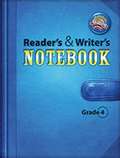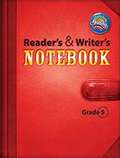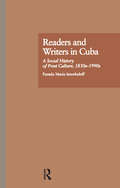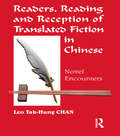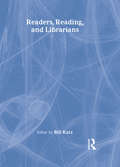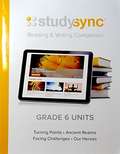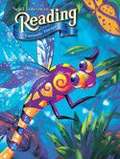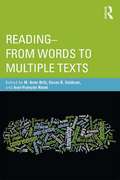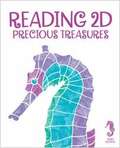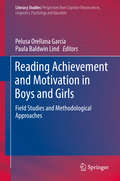- Table View
- List View
Reader's Handbook: A Student Guide for Reading and Learning
by April Nauman Donna Ogle Laura Robb Phil Laleike Mike Mcconnell- In-depth understanding of the Before, During, and After reading process- Essential skills and strategies for a variety of materials and genres- Key comprehension tools, including notetaking, outlining, cause-effect diagrams, and double-entry journals- A resource for content area reading, supplemental reading activities, tutorials, and homework support
Reader's and Writer's Notebook [Grade 4]
by Pearson EducationNIMAC-sourced textbook<P><P> <i>Advisory: Bookshare has learned that this book offers only partial accessibility. We have kept it in the collection because it is useful for some of our members. To explore further access options with us, please contact us through the Book Quality link on the right sidebar. Benetech is actively working on projects to improve accessibility issues such as these. </i>
Reader, Come Home: The Fate of the Reading Brain in a Digital World
by Maryanne WolfFrom the author of Proust and the Squid, a lively, ambitious, and deeply informative epistolary book that considers the future of the reading brain and our capacity for critical thinking, empathy, and reflection as we become increasingly dependent on digital technologies. <P><P>A decade ago, Maryanne Wolf’s Proust and the Squid revealed what we know about how the brain learns to read and how reading changes the way we think and feel. Since then, the ways we process written language have changed dramatically with many concerned about both their own changes and that of children. New research on the reading brain chronicles these changes in the brains of children and adults as they learn to read while immersed in a digitally dominated medium. <P><P>Drawing deeply on this research, this book comprises a series of letters Wolf writes to us—her beloved readers—to describe her concerns and her hopes about what is happening to the reading brain as it unavoidably changes to adapt to digital mediums. Wolf raises difficult questions, including: <P><P>Will children learn to incorporate the full range of "deep reading" processes that are at the core of the expert reading brain? <P><P>Will the mix of a seemingly infinite set of distractions for children’s attention and their quick access to immediate, voluminous information alter their ability to think for themselves? <P><P>With information at their fingertips, will the next generation learn to build their own storehouse of knowledge, which could impede the ability to make analogies and draw inferences from what they know? <P><P>Will all these influences, in turn, change the formation in children and the use in adults of "slower" cognitive processes like critical thinking, personal reflection, imagination, and empathy that comprise deep reading and that influence both how we think and how we live our lives? <P><P>Will the chain of digital influences ultimately influence the use of the critical analytical and empathic capacities necessary for a democratic society? <P><P>How can we preserve deep reading processes in future iterations of the reading brain?Who are the "good readers" of every epoch? <P><P>Concerns about attention span, critical reasoning, and over-reliance on technology are never just about children—Wolf herself has found that, though she is a reading expert, her ability to read deeply has been impacted as she has become, inevitably, increasingly dependent on screens. <P><P>Wolf draws on neuroscience, literature, education, technology, and philosophy and blends historical, literary, and scientific facts with down-to-earth examples and warm anecdotes to illuminate complex ideas that culminate in a proposal for a biliterate reading brain. Provocative and intriguing, Reader, Come Home is a roadmap that provides a cautionary but hopeful perspective on the impact of technology on our brains and our most essential intellectual capacities—and what this could mean for our future.
Reader, Grade 4, Unit 7: American Revolution, The Road to Independence
by Core Knowledge FoundationNIMAC-sourced textbook
Readers and Reading (Longman Critical Readers)
by Andrew BennettMuch literary criticism focuses on literary producers and their products, but an important part of such work considers the end-user, the reader. It asks such questions as: how far can the author condition the response of the reader, and how much does the reader create the meaning of a text? Dr Bennett's collection includes important essays from such writers and critics as Wolfgang Iser, Mary Jacobus, Roger Chartier, Michel de Certeau, Shoshana Felman, Maurice Blanchot, Paul de Man and Yves Bonnefoy. It looks in turn at deconstructionist, feminist, new historicist and psychoanalytical response to the school. The book then considers the act of reading itself, discussing such issues as the uniqueness of any reading and the difficulties involved in its analysis.
Readers and Writers Notebook: Grade 5 (Reading Street)
by Scott ForesmanThe fifth installment of the Reading Street curriculum for homeschooling series, Grade 5, is the perfect tool for your child's educational journey. This set of materials is designed to help your child develop a love of learning he or she will carry throughout the rest of his or her life. Not only does Reading Street aid you in educating your child on the subject of reading, the system is also designed to improve language arts and writing abilities. Now that your child is ready to begin the Grade 5 curriculum, he or she will encounter more challenging content and in-depth reading assignments. <P><P>All Reading Street installments integrate flawlessly with the rest of your homeschool program materials and make it easy for you to plan engaging lessons. Use the Teacher Resource DVD to print out curriculum-aligned worksheets and rubrics, and administer quizzes. Reading Street: Grade 5 comes with two volumes that cover six units. Each unit spans six weeks, for a total of 12 weeks' worth of English and Language Arts content. <P><P>Each stage of the Reading Street series is increasingly more complex, giving your child the challenge they need to develop high levels of writing, reading and language skills. The lesson plans you design using this system will keep your student interested in learning.
Readers and Writers in Cuba: A Social History of Print Culture, l830s-l990s
by Pamela Maria SmorkaloffThis study examines the evolution of Cuban literature and culture from its origins in the 19th century to the present. The early sections analyze the relationship between literary production and universities, the printing press, the abolitionist movement and the exile community from 1810 through the post-war years. Subsequent sections trace literary life from the 1920s to 1958, focusing on the links between writers, readers, and the institutions that supported literary endeavors in the Cuban Republic. The remaining chapters address Cuban literary culture from 1959 through the 1990s. This first thorough study of Cuban print culture after the 1959 revolution fills a large gap in Latin American studies with original research in archives and journals. Analysis of the relationship between literature and contemporary Cuban society is grounded in the earliest Cuban vernacular literature born in the Spanish colony and redefined in the process of nation-building in the first half of the 20th century. The book also surveys Cuban literary production in the current period of transition, confronting issues of globalization, fragmentation, and Cuba's adjustment to a post-Cold War world.
Readers in a Revolution: Bibliographical Change in the Nineteenth Century
by David McKitterickThe mid-nineteenth century brought a revolution in popular and scholarly understandings of old and second-hand books. Manuals introduced new ideas and practices to increasing numbers of collectors, exhibitions offered opportunities previously unheard of, and scholars worked together to transform how the history of printing was understood. These dramatic changes would have profound consequences for bibliographical study and collecting, accompanied as they were by a proliferation in means of access. Many ideas arising during this time would even continue to exert their influence in the digitised arena of today. This book traces this revolution to its roots in commercial and personal ties between key players in England, France and beyond, illuminating how exhibitions, libraries, booksellers, scholars and popular writers all contributed to the modern world of book studies. For students and researchers, it offers an invaluable means of orientation in a field now once again undergoing deep and wide-ranging transformations.
Readers, Reading and Reception of Translated Fiction in Chinese: Novel Encounters
by Leo Tak-hung ChanTranslated fiction has largely been under-theorized, if not altogether ignored, in literary studies. Though widely consumed, translated novels are still considered secondary versions of foreign masterpieces. Readers, Reading and Reception of Translated Fiction in Chinese recognizes that translated novels are distinct from non-translated novels, just as they are distinct from the originals from which they are derived, but they are neither secondary nor inferior. They provide different models of reality; they are split apart by two languages, two cultures and two literary systems; and they are characterized by cultural hybridity, double voicing and multiple intertextualities. With the continued popularity of translated fiction, questions related to its reading and reception take on increasing significance. Chan draws on insights from textual and narratological studies to unravel the processes through which readers interact with translated fiction. Moving from individual readings to collective reception, he considers how lay Chinese readers, as a community, 'received' translated British fiction at specific historical moments during the late twentieth and early twenty-first centuries. Case studies discussed include translations of stream-of-consciousness novels, fantasy fiction and postmodern works. In addition to lay readers, two further kinds of reader with bilingual facility are examined: the way critics and historians approach translated fiction is investigated from structuralist and poststrcuturalist perspectives. A range of novels by well-known British authors constitute the core of the study, including novels by Oscar Wilde, James Joyce, D.H. Lawrence, Virginia Woolf, John Fowles, Helen Fielding and J.K. Rowling.
Readers, Reading, and Librarians
by Bill KatzThis vital book reaffirms librarians’enthusiasm for books and readers in the midst of the evolution of libraries-from reading centers to information centers where librarians are now Web masters, information scientists, and media experts. Readers, Reading, and Librarians explores the future of the book as a medium. With nearly two hundred open-ended interviews with readers who read for pleasure, this book looks at how and why they choose or reject certain books.Readers, Reading, and Librarians examines: reasons for the current decline in pleasure reading the need for librarians to sponsor book groups the current focus on “electronic wonders” balancing the missions of acting as an advisory service for readers and maintaining your library's technological services and much more!
Reading & Writing Companion, Grade 6 Units [1-4]: Turning Points, Ancient Realms, Facing Challenges, Our Heroes (StudySync)
by BookheadEd LearningNIMAC-sourced textbook
Reading (Fantastic Voyage)
by Scott ForesmanQuality literature, built-in skill instruction, and test preparation help every child become a successful reader who is prepared for state and national tests. The Grade 1 On-Level Readers provide six weeks of review for the skills previously covered in kindergarten.
Reading (Merit Badge Series)
by Boy Scouts of AmericaThe Reading merit badge book teaches about different aspects of reading. It guides readers to learn about reading for enjoyment, learning, etc. It introduces the reader to many different kinds of reading materials. It enables the reader to achieve the Reading merit badge.
Reading - From Words to Multiple Texts
by Jean-François Rouet M. Anne Britt Susan R. GoldmanIncreasing the mastery of reading and text literacy in the general population is one of the most important challenges faced by both developed and developing societies. Providing a new reference for researchers and practitioners involved in this domain, this book brings together empirical research on the multiple levels of language that are involved in reading. It emphasizes the concrete outcomes of scientific research, and illustrates the continuity among levels. The chapters deal with clearly articulated questions, provide up-to-date reviews of the literature, and include discussions of the impacts of research outcomes for the practice of reading instruction. Furthermore, the volume addresses the gap between restricted and more functional approaches to reading competency. Finally, it addresses some of the new issues that arise from the rapid changes in reading practices that are related to the diffusion of digital technologies. Featuring contributions from authors who are among the acknowledged leaders in the field and presenting the state of the art and current controversies in reading and literacy research, this volume honors the profound impact of Charles Perfetti on reading research.
Reading 2004 Practice Book Grade 6
by Scott ForesmanScott Foresman Reading ((c)2004) components for Grade 6.
Reading 2A: All God's Creatures
by Bju PressFour reading texts provide interesting, developmentally appropriate selections from a variety of genres, such as realistic and historical fiction, fables, folktales, Bible accounts, biography, and drama as well as poetry. The reading selections provide a progression of difficulty in readability. Instruction is provided in phonics, oral reading, literary techniques, and comprehension. The selections are sequenced logically for readability and skill progression to help all students succeed.
Reading 2C: Memories to Keep
by Bju PressFour reading texts provide interesting, developmentally appropriate selections from a variety of genres, such as realistic and historical fiction, fables, folktales, Bible accounts, biography, and drama as well as poetry. The reading selections provide a progression of difficulty in readability. Instruction is provided in phonics, oral reading, literary techniques, and comprehension. The selections are sequenced logically for readability and skill progression to help all students succeed.
Reading 2D: Precious Treasures
by Kathleen Hynicka Amy Schoneweis Dottie BuckleyThe reading selections provide a progression of difficulty in readability. Instruction is provided in phonics, oral reading, literary techniques, and comprehension. The selections are sequenced logically for readability and skill progression to help all students succeed.
Reading 4 Voyages Worktext
by Bju PressThis BJU Press Reading 4: Voyages Student Worktext is designed to be used alongside the Reading 4: Voyages Student Text, 3rd Edition (not-included and sold-separately). It provides opportunities for students to more deeply engage with the text through fun activities and exercises that review the vocabulary, skills, concepts, and literary elements from the reader. Students will study story structure, complete graphic organizers, complete map work, answer comprehension questions and personal reflection questions, finish word puzzles/games, and more.
Reading 5 Fantastic Voyage (Scott Foresman )
by Scott ForesmanScott Foresman Reading Fantastic Voyage
Reading 5: Quests
by Bju PressThis book gives students an opportunity to consider new perspectives and topics. This student edition provides grade-level appropriate selections representing a variety of genres and authors. Before, during, and after reading sections emphasize comprehension strategies and literary skills. Throughout the program, students are encouraged to approach each selection from a biblical worldview. -BJU Press
Reading Above the Fray: Reliable, Research-Based Routines for Developing Decoding Skills
by Julia B. LindseyDr. Julia B. Lindsey’s evidence-based routines help young readers decode words efficiently so they can spend more energy on comprehending—and enjoying—what they read! You’ll find: 1. Need-to-know essentials of how kids learn to read. 2. Principles of high-quality foundational skills instruction. 3. Teacher-approved instructional “swaps” to improve early reading instruction. Dr. Lindsey addresses content learning, culturally responsive practices, and the importance of engaging readers from the start.
Reading Achievement and Motivation in Boys and Girls: Field Studies And Methodological Approaches (Literacy Studies #15)
by Pelusa Orellana García Paula Baldwin LindThis volume links theoretical and instructional approaches on how reading is motivated and assessed, and examines the interrelationship between reading motivation and achievement among boys and girls in culturally and geographically different settings. Much of the research on children’s reading has focused on cognitive processes; however, reading is an activity that also requires interest and motivation. These attitudes are generally defined as readers’ affect toward reading and their consequence is that children with more positive attitudes are more motivated to read. Taking into account the variability that exists within the notion of gender and age, this volume aims to examine and scrutinize previous research on the topic, as well as test theories on how the different dimensions of reading motivation vary with gender, in relation to cultural issues, motivational constructs, such as engagement and classroom climate, the role of emotions, interests and attitudes towards reading, among others. The book will be of interest to researchers, educators, graduate students, and other professionals working in the area of literacy, reading motivation, reading achievement and gender differences.

